IT
-
 U.S. and Korean Researchers Unveil Newest Research Team Member: Jaemi the Humanoid
- Project aims to enable humanoids to interact with people and their environment
June 1, 2009-- A Drexel University-led research team late last week unveiled the newest, most central member of its collaboration with a team of Korean researchers: Jaemi, a humanoid (HUBO). Jaemi HUBO embodies efforts to advance humanoid development and enhance the concept of human-robotic interaction. The project"s goal is to enable humanoids to interact with their environment, and enhancement plans include enabling the humanoid to move over rugged terrain, in unstructured environments and to interact socially with humans and handle objects.
The five-year project, funded through the National Science Foundation (NSF) Partnership for International Research and Education (PIRE) program, seeks transformative models to catalyze discovery through international research collaboration and train U.S. students and junior researchers to effectively think and work in global teams.
"The field of robotics is among the top 10 technology areas considered engines for economic growth. Korea understands this and is aggressively pursuing robotics. To stay competitive, the U.S. must do the same," said Mark Suskin, acting deputy director of NSF"s Office of International Science and Engineering. "NSF"s PIRE program and this robotics collaboration in particular, enable the U.S. to capitalize on research in other countries and remain competitive."
The PIRE research team is composed of researchers at The University of Pennsylvania, Colby College, Bryn Mawr College and Virginia Tech in the United States; and Korea Advanced Institute of Science and Technology (KAIST), Korea University and Seoul National University in Korea.
The team obtained a version of KAIST"s HUBO humanoid, which it named Jaemi HUBO and decided to house it at Drexel University. KAIST HUBO lab has become a model of cutting advance humanoid research by relatively small teams working on tight budgets.
KAIST excels in humanoid leg and body design, biped gait (walking, running, kicking), balance (modeling and control system design), and hardware integration. U.S. robotics researchers tend to enjoy an edge in locomotion over rugged, unstructured terrain; manipulation/grasping; cognition, perception and human-robot interaction; and vision (image, understanding, navigation).
This collaboration of American and Korean researchers will seek to draw on the expertise of each researcher and take Jaemi HUBO to the next level of development--that is, to improve Jaemi"s capabilities to navigate and manipulate objects and interact with people in unstructured environments. Such capabilities demand information technologies like cognition, perception and networking areas. Targeted enhancement features include a capability to move over rugged terrain and in unstructured environments and to handle objects and interact socially with humans.
Jaemi HUBO will also educate the American public, particularly young people, about the science of robotics. This education process began at the Please Touch Museum in Philadelphia on May 28, 2009, when Jaemi HUBO was unveiled and introduced to a crowded audience of children and a few adults. Neither male nor female,Jaemi connected with the children, boys and girls alike. Guided by a Drexel University graduate student, Jamei moved, spoke, danced, shook hands and lead the children in a game of Simon Says. Such access to Jaemi HUBO starkly contrasts with that afforded by other high-profile humanoids that are often protected trade secrets, largely inaccessible to the public.
Museum curators are pleased to have had Jaemi visit and entertain kids during the weekend. "At the Please Touch Museum, we promote learning through a variety of senses," said J. Willard Whitson,the museum"s vice president for exhibits and education. "A humanoid not only embodies our goal of building layers of knowledge in young people, but Jaemi helps all of us celebrate the playful side of technology."
Jaemi HUBO is now at its permanent home at Drexel University, from which travel and guest appearances may be arranged by appointment. Journalists interested in meeting and interviewing Jaemi HUBO and other research team members are encouraged to contact Lisa-Joy Zgorski at lisajoy@nsf.gov. (Press Release of U.S. National Science Foundation)
2009.06.19 View 17107
U.S. and Korean Researchers Unveil Newest Research Team Member: Jaemi the Humanoid
- Project aims to enable humanoids to interact with people and their environment
June 1, 2009-- A Drexel University-led research team late last week unveiled the newest, most central member of its collaboration with a team of Korean researchers: Jaemi, a humanoid (HUBO). Jaemi HUBO embodies efforts to advance humanoid development and enhance the concept of human-robotic interaction. The project"s goal is to enable humanoids to interact with their environment, and enhancement plans include enabling the humanoid to move over rugged terrain, in unstructured environments and to interact socially with humans and handle objects.
The five-year project, funded through the National Science Foundation (NSF) Partnership for International Research and Education (PIRE) program, seeks transformative models to catalyze discovery through international research collaboration and train U.S. students and junior researchers to effectively think and work in global teams.
"The field of robotics is among the top 10 technology areas considered engines for economic growth. Korea understands this and is aggressively pursuing robotics. To stay competitive, the U.S. must do the same," said Mark Suskin, acting deputy director of NSF"s Office of International Science and Engineering. "NSF"s PIRE program and this robotics collaboration in particular, enable the U.S. to capitalize on research in other countries and remain competitive."
The PIRE research team is composed of researchers at The University of Pennsylvania, Colby College, Bryn Mawr College and Virginia Tech in the United States; and Korea Advanced Institute of Science and Technology (KAIST), Korea University and Seoul National University in Korea.
The team obtained a version of KAIST"s HUBO humanoid, which it named Jaemi HUBO and decided to house it at Drexel University. KAIST HUBO lab has become a model of cutting advance humanoid research by relatively small teams working on tight budgets.
KAIST excels in humanoid leg and body design, biped gait (walking, running, kicking), balance (modeling and control system design), and hardware integration. U.S. robotics researchers tend to enjoy an edge in locomotion over rugged, unstructured terrain; manipulation/grasping; cognition, perception and human-robot interaction; and vision (image, understanding, navigation).
This collaboration of American and Korean researchers will seek to draw on the expertise of each researcher and take Jaemi HUBO to the next level of development--that is, to improve Jaemi"s capabilities to navigate and manipulate objects and interact with people in unstructured environments. Such capabilities demand information technologies like cognition, perception and networking areas. Targeted enhancement features include a capability to move over rugged terrain and in unstructured environments and to handle objects and interact socially with humans.
Jaemi HUBO will also educate the American public, particularly young people, about the science of robotics. This education process began at the Please Touch Museum in Philadelphia on May 28, 2009, when Jaemi HUBO was unveiled and introduced to a crowded audience of children and a few adults. Neither male nor female,Jaemi connected with the children, boys and girls alike. Guided by a Drexel University graduate student, Jamei moved, spoke, danced, shook hands and lead the children in a game of Simon Says. Such access to Jaemi HUBO starkly contrasts with that afforded by other high-profile humanoids that are often protected trade secrets, largely inaccessible to the public.
Museum curators are pleased to have had Jaemi visit and entertain kids during the weekend. "At the Please Touch Museum, we promote learning through a variety of senses," said J. Willard Whitson,the museum"s vice president for exhibits and education. "A humanoid not only embodies our goal of building layers of knowledge in young people, but Jaemi helps all of us celebrate the playful side of technology."
Jaemi HUBO is now at its permanent home at Drexel University, from which travel and guest appearances may be arranged by appointment. Journalists interested in meeting and interviewing Jaemi HUBO and other research team members are encouraged to contact Lisa-Joy Zgorski at lisajoy@nsf.gov. (Press Release of U.S. National Science Foundation)
2009.06.19 View 17107 -
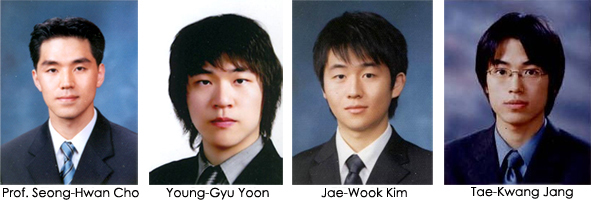 Prof. Cho's Team Awarded Best Paper Prize by IEEE
A team led by Prof. Seong-Hwan Cho of the School of Electrical Engineering and Computer Science, KAIST, won the 2009 Guillemin-Cauer Best Paper Award for their paper published in the IEEE Transactions on Circuits and Systems Journal last May, university authorities said on Thursday (June 4).
The team"s paper was entitled "A Time-based Bandpass ADC Using Time-Interleaved Voltage-Controlled Oscillators." The prize is given to a paper regarded as the best among about 350 papers published in the prestigious journal in the circuit theory area. Co-recipients of the award are Young-Gyu Yoon, Jae-Wook Kim and Tae-Kwang Jang. The award was presented at the annual 2009 International Symposium for Circuits and Systems in Taipei, Taiwan, on May 26.
The Institute of Electrical and Electronics Engineers or IEEE is an international non-profit, professional organization for the advancement of technology related to electricity. The New York-based organization has more than 365,000 members in about 150 countries making it the largest technical professional organization in the world.
2009.06.05 View 16044
Prof. Cho's Team Awarded Best Paper Prize by IEEE
A team led by Prof. Seong-Hwan Cho of the School of Electrical Engineering and Computer Science, KAIST, won the 2009 Guillemin-Cauer Best Paper Award for their paper published in the IEEE Transactions on Circuits and Systems Journal last May, university authorities said on Thursday (June 4).
The team"s paper was entitled "A Time-based Bandpass ADC Using Time-Interleaved Voltage-Controlled Oscillators." The prize is given to a paper regarded as the best among about 350 papers published in the prestigious journal in the circuit theory area. Co-recipients of the award are Young-Gyu Yoon, Jae-Wook Kim and Tae-Kwang Jang. The award was presented at the annual 2009 International Symposium for Circuits and Systems in Taipei, Taiwan, on May 26.
The Institute of Electrical and Electronics Engineers or IEEE is an international non-profit, professional organization for the advancement of technology related to electricity. The New York-based organization has more than 365,000 members in about 150 countries making it the largest technical professional organization in the world.
2009.06.05 View 16044 -
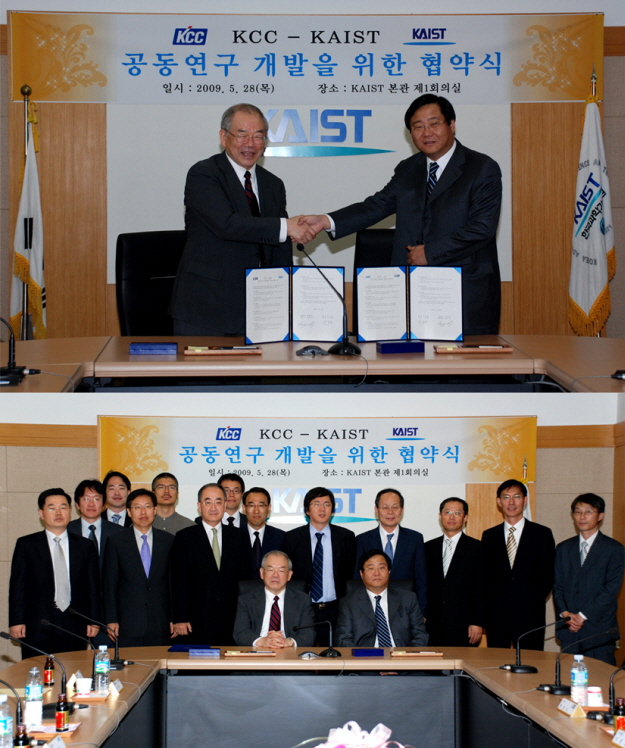 KAIST Signs Agreement for Industry-Academia Cooperation with KCC
KAIST signed an agreement for industry-academia cooperation with KCC, Korea"s leading supplier of building & industrial materials, on May 28, university sources said.
The agreement signed by KAIST President Nam-Pyo Suh and Mong-Jin Chung, Chairman of the KCC Business Group, calls for KAIST and KCC to conduct joint research for the development of new technologies in nano science, new materials areas and interdisciplinary areas.
Under the agreement, KCC will invest 5 billion won into the KAIST Institute for the NanoCentury over the next five years.
KCC Chairman Chung said: "Through this industry-academia cooperation agreement, we are seeking to give part of our profits back to community . We hope this agreement to contribute to the development of core technologies of the future in the new materials field, and nurturing specialized manpower."
2009.05.28 View 15314
KAIST Signs Agreement for Industry-Academia Cooperation with KCC
KAIST signed an agreement for industry-academia cooperation with KCC, Korea"s leading supplier of building & industrial materials, on May 28, university sources said.
The agreement signed by KAIST President Nam-Pyo Suh and Mong-Jin Chung, Chairman of the KCC Business Group, calls for KAIST and KCC to conduct joint research for the development of new technologies in nano science, new materials areas and interdisciplinary areas.
Under the agreement, KCC will invest 5 billion won into the KAIST Institute for the NanoCentury over the next five years.
KCC Chairman Chung said: "Through this industry-academia cooperation agreement, we are seeking to give part of our profits back to community . We hope this agreement to contribute to the development of core technologies of the future in the new materials field, and nurturing specialized manpower."
2009.05.28 View 15314 -
 Prof. Chung Appointed Chief Design Officer of Seoul City
Prof. Kyung-Won Chung of the Department of Industrial Design, KAIST, has been appointed as the new chief design officer of the Seoul Metropolitan City, university sources said on Tuesday (May 26).
Chung succeeded Prof, Young-Gull Kwon of Seoul National University who served as the inaugural head of the design division since 2007. The deputy-mayor level position has a two-year term.
With a vision to turn Seoul into a "global design hub," the Seoul city administration established the design division and initiated a slew of initiatives including design competitions aimed at improving the city"s looks.
Prof. Chung graduated from Seoul National University and its graduate school. Then, he earned a master"s degree from Syracuse University, New York, and a doctorate from Manchester Metropolitan University in Britain. Since February 2009, he has served as an executive of the newly-created Seoul Design Foundation. He also served as president of the Korea Institute of Design Promotion (KIDP) from February 2000 through May 2003.
2009.05.28 View 11046
Prof. Chung Appointed Chief Design Officer of Seoul City
Prof. Kyung-Won Chung of the Department of Industrial Design, KAIST, has been appointed as the new chief design officer of the Seoul Metropolitan City, university sources said on Tuesday (May 26).
Chung succeeded Prof, Young-Gull Kwon of Seoul National University who served as the inaugural head of the design division since 2007. The deputy-mayor level position has a two-year term.
With a vision to turn Seoul into a "global design hub," the Seoul city administration established the design division and initiated a slew of initiatives including design competitions aimed at improving the city"s looks.
Prof. Chung graduated from Seoul National University and its graduate school. Then, he earned a master"s degree from Syracuse University, New York, and a doctorate from Manchester Metropolitan University in Britain. Since February 2009, he has served as an executive of the newly-created Seoul Design Foundation. He also served as president of the Korea Institute of Design Promotion (KIDP) from February 2000 through May 2003.
2009.05.28 View 11046 -
 KAIST Ranked Seventh in Chosun-QS 2009 Asian University Rankings
- Major Criteria in Research, Education, Globalization
KAIST ranked top in Korea and seventh in Asia in a ranking compiled jointly by the Chosun Ilbo, a major Korean daily, and global university evaluation institute QS of Britain.
In the rankings released on Tuesday (May 12), KAIST scored 94.9 based on the full 100 of the top-ranking university, the University of Hong Kong. KAIST was closely followed by Seoul National University (SNU), which ranked 8th in the Asian ranking. KAIST outpaced SNU in terms of globalization, but lagged behind in terms of peer review and recruiters review.
The Chosun Ilbo said that KAIST achieved the distinction by encouraging competition among research professors, introducing competitive educational systems such as conducting all classes in English, and speeding up globalization drive based on a strong leadership of President Nam-Pyo Suh.
In an interview with the daily published on the same day, President Nam-Pyo Suh expressed enthusiasm for stepping up his university"s drive to make it one of the world"s leading research universities, without resting on its present reputation. "The goal of KAIST is to stand at the forefront in addressing critical problems facing the humanity in the 21st century. The problems include alternative energies and transportation and logistics. If we resolve these problems, KAIST will join the ranks of the world"s best universities," Suh said.
The evaluation, the only such survey in Asia, was conducted with 463 universities in 11 countries, including 106 in Korea. The universities were ranked for competitiveness in four categories -- research quality (60 percent), teaching quality (20 percent), graduate employability (10 percent) and international outlook (10 percent).
The top-ranked University of Hong Kong was followed by Chinese University of Hong Kong, Tokyo University, Hong Kong University of Science and Technology, and Osaka University.
The top 100 Asian universities include 17 Korean universities, 33 Japanese, 11 Chinese, seven Indian, six in Hong Kong and two in Singapore.
Universities were ranked through a quantitative analysis based on data submitted by the universities in March and a qualitative analysis based on the competitiveness of professors and graduates evaluated by about 3,100 academics and businesspeople around the world.
Meanwhile, KAIST was ranked 95th among top 200 universities of the world in the Times Higher Education-QS World University rankings in 2008. It ranked 34th in the area of engineering and information technology, and 46th in natural science.
2009.05.13 View 13627
KAIST Ranked Seventh in Chosun-QS 2009 Asian University Rankings
- Major Criteria in Research, Education, Globalization
KAIST ranked top in Korea and seventh in Asia in a ranking compiled jointly by the Chosun Ilbo, a major Korean daily, and global university evaluation institute QS of Britain.
In the rankings released on Tuesday (May 12), KAIST scored 94.9 based on the full 100 of the top-ranking university, the University of Hong Kong. KAIST was closely followed by Seoul National University (SNU), which ranked 8th in the Asian ranking. KAIST outpaced SNU in terms of globalization, but lagged behind in terms of peer review and recruiters review.
The Chosun Ilbo said that KAIST achieved the distinction by encouraging competition among research professors, introducing competitive educational systems such as conducting all classes in English, and speeding up globalization drive based on a strong leadership of President Nam-Pyo Suh.
In an interview with the daily published on the same day, President Nam-Pyo Suh expressed enthusiasm for stepping up his university"s drive to make it one of the world"s leading research universities, without resting on its present reputation. "The goal of KAIST is to stand at the forefront in addressing critical problems facing the humanity in the 21st century. The problems include alternative energies and transportation and logistics. If we resolve these problems, KAIST will join the ranks of the world"s best universities," Suh said.
The evaluation, the only such survey in Asia, was conducted with 463 universities in 11 countries, including 106 in Korea. The universities were ranked for competitiveness in four categories -- research quality (60 percent), teaching quality (20 percent), graduate employability (10 percent) and international outlook (10 percent).
The top-ranked University of Hong Kong was followed by Chinese University of Hong Kong, Tokyo University, Hong Kong University of Science and Technology, and Osaka University.
The top 100 Asian universities include 17 Korean universities, 33 Japanese, 11 Chinese, seven Indian, six in Hong Kong and two in Singapore.
Universities were ranked through a quantitative analysis based on data submitted by the universities in March and a qualitative analysis based on the competitiveness of professors and graduates evaluated by about 3,100 academics and businesspeople around the world.
Meanwhile, KAIST was ranked 95th among top 200 universities of the world in the Times Higher Education-QS World University rankings in 2008. It ranked 34th in the area of engineering and information technology, and 46th in natural science.
2009.05.13 View 13627 -
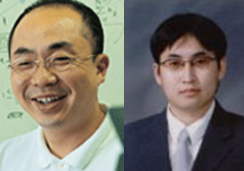 Prof. Chong Unveils New Human Movement Model
A KAIST research team headed by Prof. Song Chong of the School of Electrical Engineering and Computer Science has developed a new statistical model that simulates human mobility patterns, mimicking the way people move over the course of a day, a month or longer, university sources said on Tuesday (May 12).
The model, developed in collaboration with scientists at North Carolina State University, is the first to represent the regular movement patterns of humans using statistical data.
The model has a variety of potential uses, ranging from land use planning to public health studies on epidemic disease.
The researchers gave global positioning system (GPS) devices to approximately 100 volunteers at five locations in the U.S. and South Korea and tracked the participants" movements over time. By tracing the points where the study participants stopped, and their movement trajectories, researchers were able to determine patterns of mobility behavior.
The researchers were then able to emulate these fundamental statistical properties of human mobility into a model that could be used to represent the regular daily movement of humans. The model, called Self-similar Least Action Walk (SLAW), will have a wide array of practical applications.
The research, "SLAW: A Mobility Model for Human Walks," was presented on April 20 at the 28th IEEE Conference on Computer Communications in Rio de Janeiro, Brazil. The National Science Foundation of the U.S. funded the research.
2009.05.13 View 15887
Prof. Chong Unveils New Human Movement Model
A KAIST research team headed by Prof. Song Chong of the School of Electrical Engineering and Computer Science has developed a new statistical model that simulates human mobility patterns, mimicking the way people move over the course of a day, a month or longer, university sources said on Tuesday (May 12).
The model, developed in collaboration with scientists at North Carolina State University, is the first to represent the regular movement patterns of humans using statistical data.
The model has a variety of potential uses, ranging from land use planning to public health studies on epidemic disease.
The researchers gave global positioning system (GPS) devices to approximately 100 volunteers at five locations in the U.S. and South Korea and tracked the participants" movements over time. By tracing the points where the study participants stopped, and their movement trajectories, researchers were able to determine patterns of mobility behavior.
The researchers were then able to emulate these fundamental statistical properties of human mobility into a model that could be used to represent the regular daily movement of humans. The model, called Self-similar Least Action Walk (SLAW), will have a wide array of practical applications.
The research, "SLAW: A Mobility Model for Human Walks," was presented on April 20 at the 28th IEEE Conference on Computer Communications in Rio de Janeiro, Brazil. The National Science Foundation of the U.S. funded the research.
2009.05.13 View 15887 -
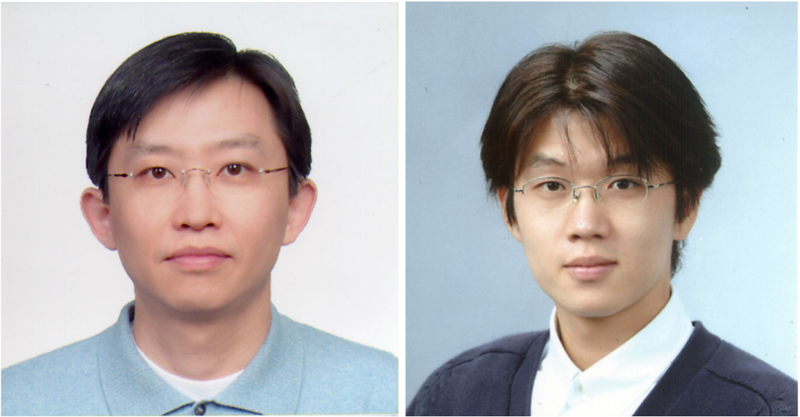 KAIST Professor Unveils New Method of Manufacturing Complex Nano-wire
A KAIST research team led by Prof. Sang-Ouk Kim of the Department of Materials Science and Engineering has discovered a new nanowire manufacturing method, university sources said on Monday (May 11).
The KAIST researchers successfully demonstrated soft graphoepitaxy of block copolymer assembly as a facile, scalable nanolithography for highly ordered sub-30-nm scale features. Graphoepitaxy is a new technique that uses artificial surface relief structure to induce crystallographic orientation in thin films.
Various morphologies of hierarchical block copolymer assembly were achieved by means of disposable topographic confinement of photoresist pattern. Unlike usual graphoepitaxy, soft graphoepitaxy generates the functional nanostrutures of metal and semiconductor nanowire arrays without any trace of structure-directing topographic pattern.
The discovery was featured in the May 7 edition of Nano-Letters. Application has been made for the domestic patent of the new method.
The new method is expected to be advantageous for multi-layer overlay processing required for complex device architecture, the sources said.
2009.05.12 View 12277
KAIST Professor Unveils New Method of Manufacturing Complex Nano-wire
A KAIST research team led by Prof. Sang-Ouk Kim of the Department of Materials Science and Engineering has discovered a new nanowire manufacturing method, university sources said on Monday (May 11).
The KAIST researchers successfully demonstrated soft graphoepitaxy of block copolymer assembly as a facile, scalable nanolithography for highly ordered sub-30-nm scale features. Graphoepitaxy is a new technique that uses artificial surface relief structure to induce crystallographic orientation in thin films.
Various morphologies of hierarchical block copolymer assembly were achieved by means of disposable topographic confinement of photoresist pattern. Unlike usual graphoepitaxy, soft graphoepitaxy generates the functional nanostrutures of metal and semiconductor nanowire arrays without any trace of structure-directing topographic pattern.
The discovery was featured in the May 7 edition of Nano-Letters. Application has been made for the domestic patent of the new method.
The new method is expected to be advantageous for multi-layer overlay processing required for complex device architecture, the sources said.
2009.05.12 View 12277 -
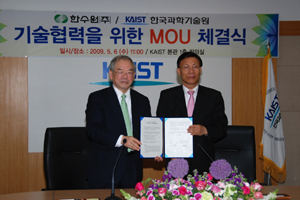 KAIST, KHNP Sign MOU on Nuclear Technology Development
KAIST signed a memorandum of understanding with the Korea Hydro & Nuclear Power Co. (KHNP) on Wednesday (May 6) to upgrade cooperation between the two organizations in nuclear power technology development.
On hand at the signing ceremony at KAIST were KAIST President Nam-Pyo Suh, KHNP President Jong-Shin Kim and other related officials.
The agreement calls for increased efficiency and synergy effect in the development of nuclear power generation by KAIST and KHNP to gain greater competitiveness in the exportation of nuclear power technologies.
KHNP is responsible for the operation of all nuclear and hydraulic power plants in Korea which supply about 40 percent of the nation"s electric power demand. It is the largest among the six power generating subsidiaries that separated from Korea Electric Power Corporation (KEPCO) in April 2001.
2009.05.07 View 13231
KAIST, KHNP Sign MOU on Nuclear Technology Development
KAIST signed a memorandum of understanding with the Korea Hydro & Nuclear Power Co. (KHNP) on Wednesday (May 6) to upgrade cooperation between the two organizations in nuclear power technology development.
On hand at the signing ceremony at KAIST were KAIST President Nam-Pyo Suh, KHNP President Jong-Shin Kim and other related officials.
The agreement calls for increased efficiency and synergy effect in the development of nuclear power generation by KAIST and KHNP to gain greater competitiveness in the exportation of nuclear power technologies.
KHNP is responsible for the operation of all nuclear and hydraulic power plants in Korea which supply about 40 percent of the nation"s electric power demand. It is the largest among the six power generating subsidiaries that separated from Korea Electric Power Corporation (KEPCO) in April 2001.
2009.05.07 View 13231 -
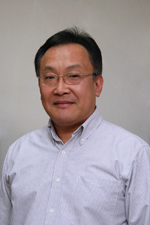 KAIST Prof. Park Selected as Winner of Clemson Award
Professor Tae-Gwan Park of the Department of Biological Sciences, KAIST, was chosen as the winner of the 2009 Clemson Award for Fundamental Research, university authorities said on Tuesday (April 7).
The award is the highest recognition of the Society for Biomaterials, an international organization of more than 3,000 members that promotes research in the field of biomaterials. Prof. Park is cited for his outstanding achievements in interdisciplinary research covering gene transferring, gene therapy and neogenesis. It is rare for a non-U.S. national to win the prize in the 36-year history of the award.
The award will be given to Professor Park at the Annual Meeting of the society which will be held in San Antonio, Texas, on April 22.
2009.04.09 View 14339
KAIST Prof. Park Selected as Winner of Clemson Award
Professor Tae-Gwan Park of the Department of Biological Sciences, KAIST, was chosen as the winner of the 2009 Clemson Award for Fundamental Research, university authorities said on Tuesday (April 7).
The award is the highest recognition of the Society for Biomaterials, an international organization of more than 3,000 members that promotes research in the field of biomaterials. Prof. Park is cited for his outstanding achievements in interdisciplinary research covering gene transferring, gene therapy and neogenesis. It is rare for a non-U.S. national to win the prize in the 36-year history of the award.
The award will be given to Professor Park at the Annual Meeting of the society which will be held in San Antonio, Texas, on April 22.
2009.04.09 View 14339 -
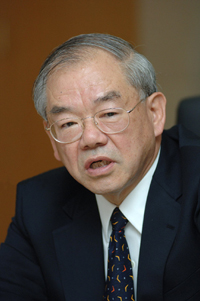 President Suh to Receive Honorary Doctorate from Romanian University
KAIST President Nam-Pyo Suh will receive an honorary doctorate degree from Babes-Bolyai University in Cluj-Napoca, Romania, in a ceremony at the university on April 3, school authorities said.
Andrei Marga, rector of the largest Romanian university, said in a letter to President Suh that the university decided to award Suh the title of Doctor Honoris Cause of Babes-Bolyai University, the highest academic honor of the university, in recognition of his "prestigious actions as academic leader of a university known worldwide and for contribution to cooperation between Romania and South Korea."
The university"s honorary doctorate is awarded to persons with illustrious achievements in the fields of science, technology, art, philosophy, and theology. Recent winners of the honor include Pope Benedict XVI; Cardinal Walter Kasper, President of the Pontifical Council for Promoting Christian Unity in Rome; Nobel Prize winners Rich Ernest of Switzerland and George Palade of the United States; philosophers Paul Ricoeur of France and Richard Rorty of the United States, among others.
The Babes-Bolyai University located in Cluj-Napoca with about 50,000 students offers education in three different languages, Romanian, Hungarian and German. It has the longest academic history in Romania, founded as a Jesuit college in 1581.
2009.04.02 View 13354
President Suh to Receive Honorary Doctorate from Romanian University
KAIST President Nam-Pyo Suh will receive an honorary doctorate degree from Babes-Bolyai University in Cluj-Napoca, Romania, in a ceremony at the university on April 3, school authorities said.
Andrei Marga, rector of the largest Romanian university, said in a letter to President Suh that the university decided to award Suh the title of Doctor Honoris Cause of Babes-Bolyai University, the highest academic honor of the university, in recognition of his "prestigious actions as academic leader of a university known worldwide and for contribution to cooperation between Romania and South Korea."
The university"s honorary doctorate is awarded to persons with illustrious achievements in the fields of science, technology, art, philosophy, and theology. Recent winners of the honor include Pope Benedict XVI; Cardinal Walter Kasper, President of the Pontifical Council for Promoting Christian Unity in Rome; Nobel Prize winners Rich Ernest of Switzerland and George Palade of the United States; philosophers Paul Ricoeur of France and Richard Rorty of the United States, among others.
The Babes-Bolyai University located in Cluj-Napoca with about 50,000 students offers education in three different languages, Romanian, Hungarian and German. It has the longest academic history in Romania, founded as a Jesuit college in 1581.
2009.04.02 View 13354 -
 KAIST Research Team Discovers Process for Rapid Growth of N-Doped CNT Arrays
A team of scientists led by Profs. Sang-Ouk Kim, Won-Jong Lee and Duck-Hyun Lee of the Department of Materials Science and Engineering has found a straightforward process for rapid growth of wall-number selected, nitrogen-doped carbon nanotube (CNT) arrays, university officials said on Monday (March 16).
KAIST researchers prepared highly uniform nanopatterned iron catalyst arrays by tilted deposition through block copolymer nanotemplates. This remarkably fast growth of highly uniform N-doped CNTs, whose material properties and chemical functionalizability are reinforced by N-doping, offers a new area of a large-scale nanofabrication, potentially useful for diverse nano-devices.
Carbon nanotubes (CNTs) are of broad technical interest in electronics, photonics, energy devices, and other applications. However, establishing a straightforward process for mass production of uniform CNTs with desired structure and properties has been a long-standing challenge.
In particular, it was strongly desired to precisely control the numbers of walls and diameter of CNTs, which are decisive parameters for the physical properties of CNTs. In this respect, the preparation of monodisperse catalyst array having a narrow size distribution is generally considered an effective pathway to produce well-defined CNTs, since the number of walls and diameter of the produced CNTs are closely related to the catalyst size.
The finding was featured in the March 13 edition of Nano Letters, a leading journal in the nano technology field.
2009.03.20 View 15822
KAIST Research Team Discovers Process for Rapid Growth of N-Doped CNT Arrays
A team of scientists led by Profs. Sang-Ouk Kim, Won-Jong Lee and Duck-Hyun Lee of the Department of Materials Science and Engineering has found a straightforward process for rapid growth of wall-number selected, nitrogen-doped carbon nanotube (CNT) arrays, university officials said on Monday (March 16).
KAIST researchers prepared highly uniform nanopatterned iron catalyst arrays by tilted deposition through block copolymer nanotemplates. This remarkably fast growth of highly uniform N-doped CNTs, whose material properties and chemical functionalizability are reinforced by N-doping, offers a new area of a large-scale nanofabrication, potentially useful for diverse nano-devices.
Carbon nanotubes (CNTs) are of broad technical interest in electronics, photonics, energy devices, and other applications. However, establishing a straightforward process for mass production of uniform CNTs with desired structure and properties has been a long-standing challenge.
In particular, it was strongly desired to precisely control the numbers of walls and diameter of CNTs, which are decisive parameters for the physical properties of CNTs. In this respect, the preparation of monodisperse catalyst array having a narrow size distribution is generally considered an effective pathway to produce well-defined CNTs, since the number of walls and diameter of the produced CNTs are closely related to the catalyst size.
The finding was featured in the March 13 edition of Nano Letters, a leading journal in the nano technology field.
2009.03.20 View 15822 -
 Workshop on Biomedical IC to Be Held on March 26
KAIST will hold a workshop on "biomedical IC for future healthcare system" on March 26 at a lecture room of the School of Electrical Engineering & Computer Science. The workshop is organized by SEECS and the Korean Institute of Next Generation Computing.
At the workshop, a variety of new technologies expected to expedite the development of biomedical systems will be presented. KAIST Prof. Hoi-Jun Yoo will speak on the "body channel communication" using the human body as the signal transmission medium and Dr. Seung-Hwan Kim of Electronics and Telecommunications Research Institute (ETRI) on a wearable vital sign monitoring system.
Other subjects are CMOS (complementary metal-oxide semiconductor) fully electronic biosensor for biomolecular detection to be presented by KAIST Prof. Gyu-Hyeong Cho; nerve interface and IC (integrated circuit) system design by KAIST Prof. Yoon-gi Nam; design of neural recording and stimulation IC using time-varying magnetic field by KAIST Prof. Seong-Hwan Cho; low power multi-core digital signal processor for hearing aid by Dong-Wook Kim, senior researcher at the Samsung Advanced Institute of Technology; and a non-contact cardiac sensor by KAIST Prof. Seung-Chul Hong.
With the advent of the ageing society, medical expenses of the elderly people are rapidly increasing. As a way to address the issue, interests are growing in "ubiquitous healthcare," a technology that uses a large number of environmental and patient sensors and actuators to monitor and improve patients’ physical and mental condition.
The upcoming workshop is the first academic event on biomedical integrated chips to be held in Korea. The workshop will provide a valuable opportunity for experts in biomedical area to get together and examine the present status of Korean biomedical area and discuss about its future, KAIST officials said.
2009.03.20 View 21024
Workshop on Biomedical IC to Be Held on March 26
KAIST will hold a workshop on "biomedical IC for future healthcare system" on March 26 at a lecture room of the School of Electrical Engineering & Computer Science. The workshop is organized by SEECS and the Korean Institute of Next Generation Computing.
At the workshop, a variety of new technologies expected to expedite the development of biomedical systems will be presented. KAIST Prof. Hoi-Jun Yoo will speak on the "body channel communication" using the human body as the signal transmission medium and Dr. Seung-Hwan Kim of Electronics and Telecommunications Research Institute (ETRI) on a wearable vital sign monitoring system.
Other subjects are CMOS (complementary metal-oxide semiconductor) fully electronic biosensor for biomolecular detection to be presented by KAIST Prof. Gyu-Hyeong Cho; nerve interface and IC (integrated circuit) system design by KAIST Prof. Yoon-gi Nam; design of neural recording and stimulation IC using time-varying magnetic field by KAIST Prof. Seong-Hwan Cho; low power multi-core digital signal processor for hearing aid by Dong-Wook Kim, senior researcher at the Samsung Advanced Institute of Technology; and a non-contact cardiac sensor by KAIST Prof. Seung-Chul Hong.
With the advent of the ageing society, medical expenses of the elderly people are rapidly increasing. As a way to address the issue, interests are growing in "ubiquitous healthcare," a technology that uses a large number of environmental and patient sensors and actuators to monitor and improve patients’ physical and mental condition.
The upcoming workshop is the first academic event on biomedical integrated chips to be held in Korea. The workshop will provide a valuable opportunity for experts in biomedical area to get together and examine the present status of Korean biomedical area and discuss about its future, KAIST officials said.
2009.03.20 View 21024